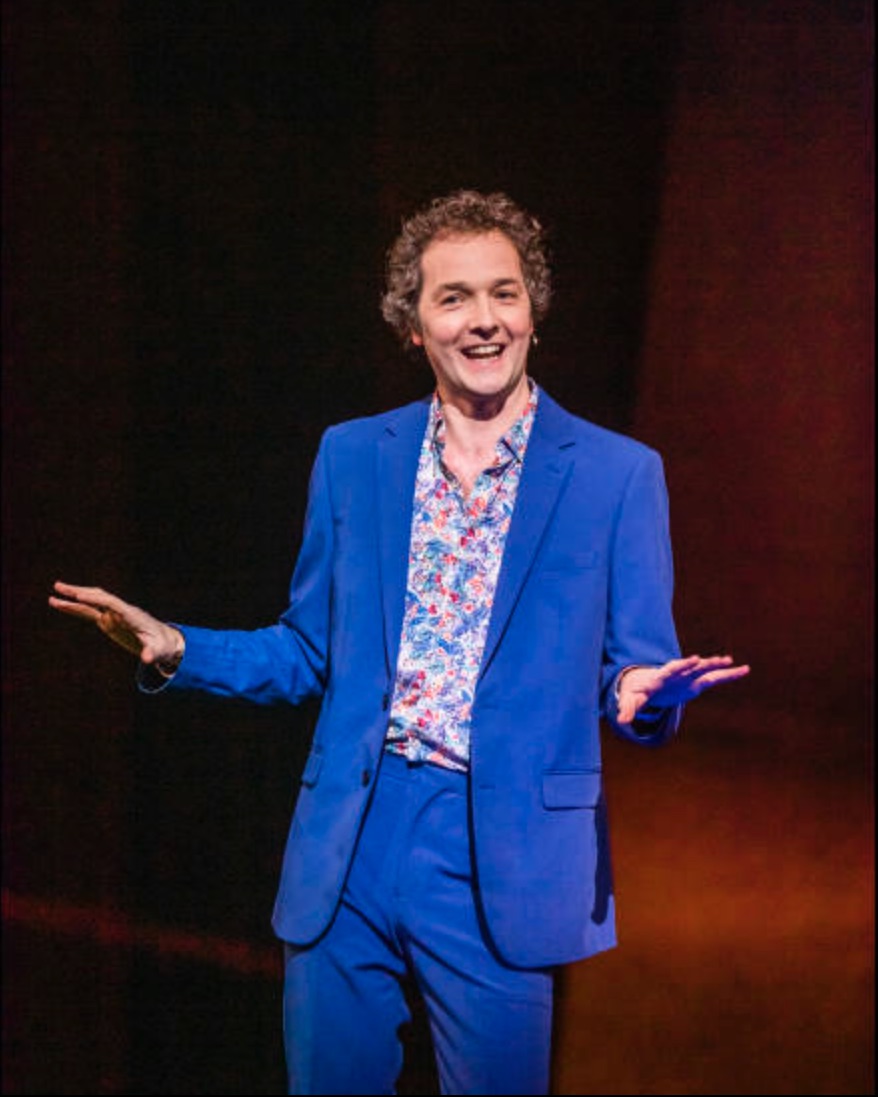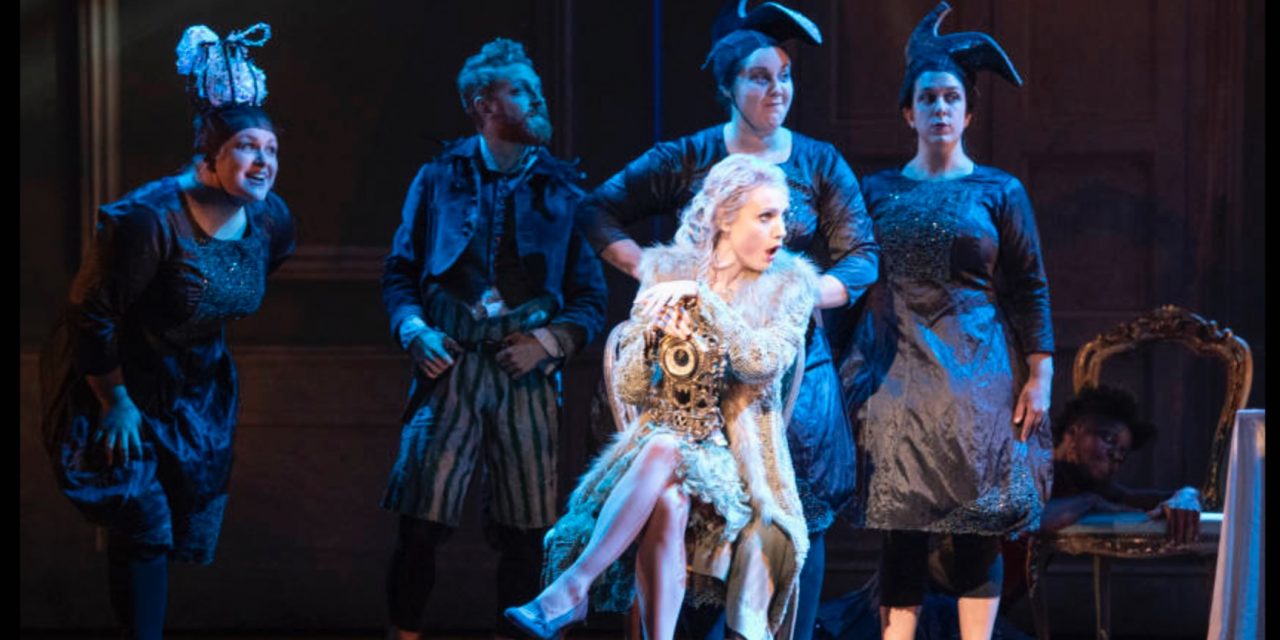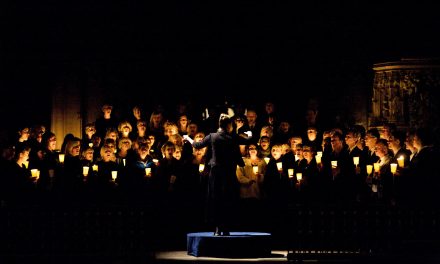The Fairy (Caroline Wettergreen) – photos supplied by Glyndebourne
The annual visit of Glyndebourne Opera to Norwich Theatre Royal is always an event that promotes debate and some controversy, and 2018 is no exception to this rule. The company brought us three distinctive evenings of entertainment: La Traviata, Cendrillon, and then finally La Traviata Behind The Curtain, an examination of the structure and staging of the most performed opera in the canon of perennial favourites.
Verdi’s La Traviata features some of the most sublime yet complex music ever composed for an opera, and most of the melodies will be immediately familiar to us. Courtesan Violetta Valéry (Mané Galoyan) lives a life dedicated to partying and pleasure and is dependent upon her rich clients for her income. However she is also dying from Tuberculosis, making her ever more determined to gain pleasure from her brief life. Into this world of partying and gambling steps young Alfredo Germont (Tenor Luis Gomez) who declares his love for Violetta. They retreat to live in the bliss of new love, but this idyll is cut short as she runs out of money. While he goes off to try and sort this out his father Giorgio Germont (Baritone Noel Bouley) comes to plead with Violetta to give up this scandalous liaison so that his daughter, Alfredo’s sister, can marry in polite society. Violetta is traumatised but agrees and returns to the protection of Baron Douphol and the louche life of her Parisian society. Alfredo follows her but she feels compelled to dismiss him while really yearning for his love. They are eventually reunited, but Violetta is dying.
Verdi’s score enhances the emotional power of the situation with an interplay of arias and recitative from the three principals as they range through emotions from love through anger to resignation. At the time of its first performance in 1853 this work would have shocked society as the empathetic heroine is a prostitute – however privileged her customers might be she would still be seen as a mere commodity to be used and cast aside, yet Verdi gives us a fully developed and rounded human character full of virtues and selflessness. Mané Galoyan is superb giving a faultless account of this complex role combining vulnerability and decline with immense resolve and strength of character. While Luis Gomez may not be everyone’s stereotype romantic lead he gives a fine account of the young man who gives up everything for love. He combines the rash brashness of an angry young man with the tender thoughtfulness of a devoted lover. Their youthful interplay is contrasted with the baritone authority of his father (Noel Bouley), initially stern but in the end broken by his guilt at his interference with their passion.
A small but faultless orchestra is conducted by Christoph Altstaedt. The set design is as dramatic as the plot – two large curved screens stretch up to the gods and are moved to create intimate or large spaces as required. Costumes are more Weimar nightclub than Nineteenth Century Paris, but it works, mostly. There are some decidedly weird gaming tables and lamps built with a severely distorted perspective that distract rather than support the action, but mostly the set is kept simple. A straightforward production which allows us to concentrate on the fine singing and emotions of Alfredo and Violetta.
Cendrillon is a very different offer, many (like me) may be less familiar with Massenet’s work. The story is the familiar Cinderella, but with a French twist and some frankly bonkers staging it presents a rather confusing tableau where we rely on our basic knowledge of the fable to see us through. Cendrillon tonight was Jennifer Witton. Her evil stepmother was given a powerfully modern approach by Agnes Zwierko – think TOWIE and the Kardashians – and her daughters are equally contemporary as self obsessed and selfie obsessed young horrors brought to life by Eduardo Melo and Kezia Bienek. Cendrillon’s long suffering father Pandolphe (William Dazeley) wearies of the glitter of his second wife’s social ambitions and retreats back to his country farm with Cendrillon. The Fairy Godmother role is excellently sung by Caroline Wettergreen, but her character is just odd – she seems quite resentful of her tasks and spends much time on stage pacing about looking right mardy and smoking a fag. The Prince is played with great charm by Mezzo Soprano Eléonore Pancrazi but she overlaps confusingly as the maid of Pandolphe’s household, tending to the ailing Cendrillon in her sadness after the ball.
The over-the-top design of this production while impressive is often quite jarring, referencing images from Midsummer Nights Dream, Surrealism, and other diverse sources including the worst of reality TV. There is a lot of stuff about shoes which is hard to fathom, they even feature as headgear, yet the fabled ‘glass slipper’ looks like nothing so much as a pantomime boot. The choir are somewhere between the stuff of nightmares after one Pernod too many and the line up at an Andrew Logan party. However, this lot are Glyndebourne throughout, so however bizarre the visuals the singing is superb – for me Caroline Wettergreen as The Fairy stood out, along with Eléonore Pancrazi while she was being the Prince.
This production includes some impressive dancing and physical comedy and once again a monumental set, often featuring a huge ‘hall of mirrors’ of triangular glazed structures that serve many purposes and give unexpected glimpses into the wings and corners of the stage. The bizarre and modern visuals sometimes seem to be rather detached from the Massenet score which tells a gentler tale than the dazzling tableau set before us designer Jon Bausor. There are odd little vignettes such as the troupe of chain smoking doctors who attend to Prince Charming.
This is certainly an enjoyable show, but if you were a visitor from a planet with no Cinderella you would be unlikely to grasp the story firmly but would leave with a strong conviction that shoes were central to human life.
 The third evening appeared initially less appealing, indeed did not appear to sell out, a shame as it was actually an enjoyable and illuminating insight into how opera is constructed and presented. Compere Chris Addison was a good choice to whizz us through this entertaining programme which also featured some hearty chunks of La Traviata (with different leads – Maria Bochmanova as Violetta and Nico Darmanin as Alfredo). There were some great moments, such as seeing Glyndebourne’s finest giving us a brief taste of Gangnam style dance, to prove a point about the impact of La Traviata when it first appeared. There were welcome insights into the work of the costume, make-up and wig folk as well as interviews with the conductor Ben Glassberg and leading performers. Above all this show gave us a brief introduction to the form and structure of opera, along with some pertinent history. A joyful evening that I would recommend if you get the chance to catch it. The cast managed to follow me to the nearby pub where their exuberance was notable – they may be some of the world’s finest singers and musicians but they there was no haughty detachment on view here.
The third evening appeared initially less appealing, indeed did not appear to sell out, a shame as it was actually an enjoyable and illuminating insight into how opera is constructed and presented. Compere Chris Addison was a good choice to whizz us through this entertaining programme which also featured some hearty chunks of La Traviata (with different leads – Maria Bochmanova as Violetta and Nico Darmanin as Alfredo). There were some great moments, such as seeing Glyndebourne’s finest giving us a brief taste of Gangnam style dance, to prove a point about the impact of La Traviata when it first appeared. There were welcome insights into the work of the costume, make-up and wig folk as well as interviews with the conductor Ben Glassberg and leading performers. Above all this show gave us a brief introduction to the form and structure of opera, along with some pertinent history. A joyful evening that I would recommend if you get the chance to catch it. The cast managed to follow me to the nearby pub where their exuberance was notable – they may be some of the world’s finest singers and musicians but they there was no haughty detachment on view here.
© Julian Swainson 2018





Recent Comments